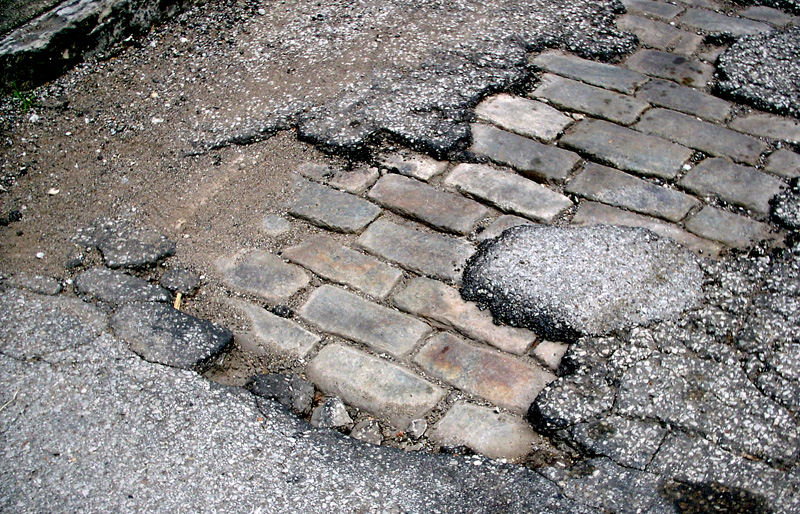
Many of Louisville’s streets were originally paved in brick or cobblestone. Today, we occasionally can find a patch of cobblestones poking through damaged asphalt, but there are very few actual brick or cobblestone streets left in the city. It seems most will either love or hate cobblestone streets. One stretch of Fourth Street near Broadway had its cobblestones ripped up several years ago allegedly after theater-going ladies couldn’t walk across them with high heels. We say some streets won’t work with cobblestones, but others are just waiting to be restored.
There are definite pros and cons with a cobbled street. They help with traffic calming as the texture keeps cars going at a manageable pace and they definitely help create a sort of historic charm, but they are expensive to set correctly and can present challenges for biking. Proper design could take care of this, however.
A properly installed and well maintained cobblestone street can be pretty smooth, too. In one Brooklyn neighborhood in New York, the city is spending over $20 million to restore and repave dilapidated cobblestone streets back to their original condition. Our cobblestone streets are still there, just inches below the asphalt surface. From major roads like Market Street to minor alleys, there are tens of thousands of stones sitting idle.
Not every street should be cobbled. Smaller neighborhood streets where traffic speeds should be less are ideal candidates. Guthrie or Armory Street downtown or Washington or Franklin Streets in Butchertown or any number of narrow streets in Louisville historic neighborhoods come to mind. Should we re-cobble Louisville? What streets are the best candidates for restoration or why should we stick with our smooth blacktop roads? Send in your opinions in the comments.



I think the best use of cobblestone is in district intersections, but then put colored pavement edged with cobblestones in the crosswalk. This way you can get the nice look and it will slow traffic but the actual walks are smooth. And a nice area for these are historic commercial (retail/tavern) districts with significant pedestrian activity.
There are several streets in Clifton that use brick pavers.
-Embry Avenue between Pope Street and William Street
-Haldeman Avneue on the sloped portion near Brownsboro Road
-Sycamore Street between Jane Street Keats Avenue
-State Street on the north side of Frankfort Avenue, stretching from Frankfort two blocks to the railroad tracks
-State Street on the sloped portion near Brownsboro Road
Unfortunately, work on underground utilities has turned some areas into a patchwork of miss-matched brick and asphalt. State Street near Frankfort Avenue also has problems with ponding during rain events due to the grading at the intersection.
Love the post. I’ve been thinking about this for a while. We need to catalog what we have. Anyone interested in building a Google Map app to keep track of Louisville’s cobblestone streets?
Also, has anyone successfully removed asphalt and restored the cobblestone? I have a perfect alley candidate.
I agree intersections are a good use for cobblestones. The texture causes cars to slow down instead of speeding through to catch the yellow light and the smooth crosswalks benefits everyone. It would still be nice to have some (of course not all) of Louisville's historic neighborhoods take on extensive use of cobbled streets, though. It could become a defining design feature of the areas that adopt it.
I would like seeing more cobbled streets as well, but at this point it is clearly not Metro government's radar. Without their support — or a Metro Council member's discretionary fund money — what options are there?
Involving neighborhood and biz associations (who can also help enlist Council/Mayoral support). Old Louisville and Cherokee Triangle are great examples of neighborhoods taking charge of their streets. Each have funded many streetscape improvements through event revenues. Cherokee even rebuilt the bathrooms in Willow Park. Councilmembers may be willing to do an intersection, or match funds with the neighborhood.
I live on Pope st. in Clifton. I would love to see the brick street restored. It would help with slowing the traffic flow as well.